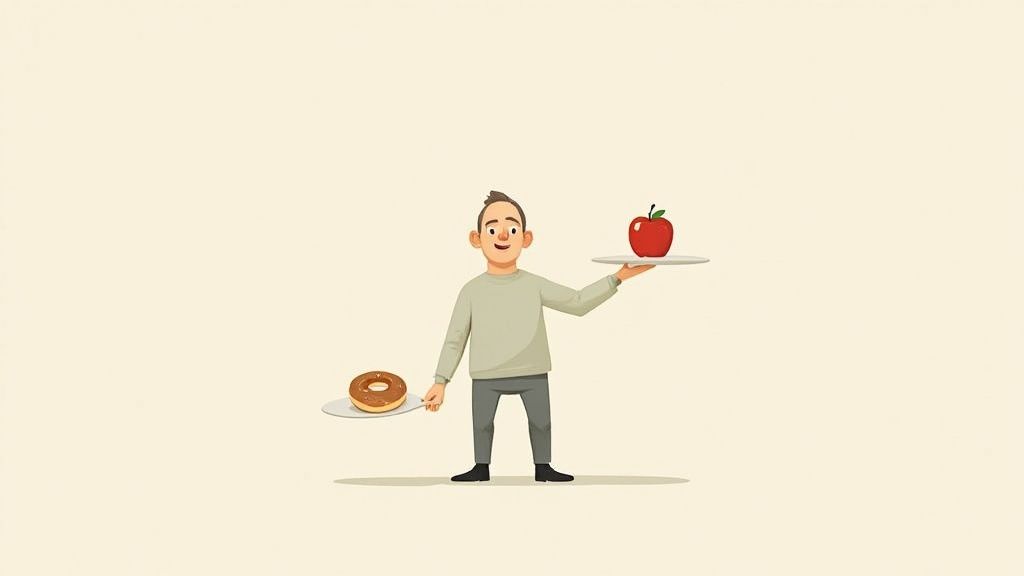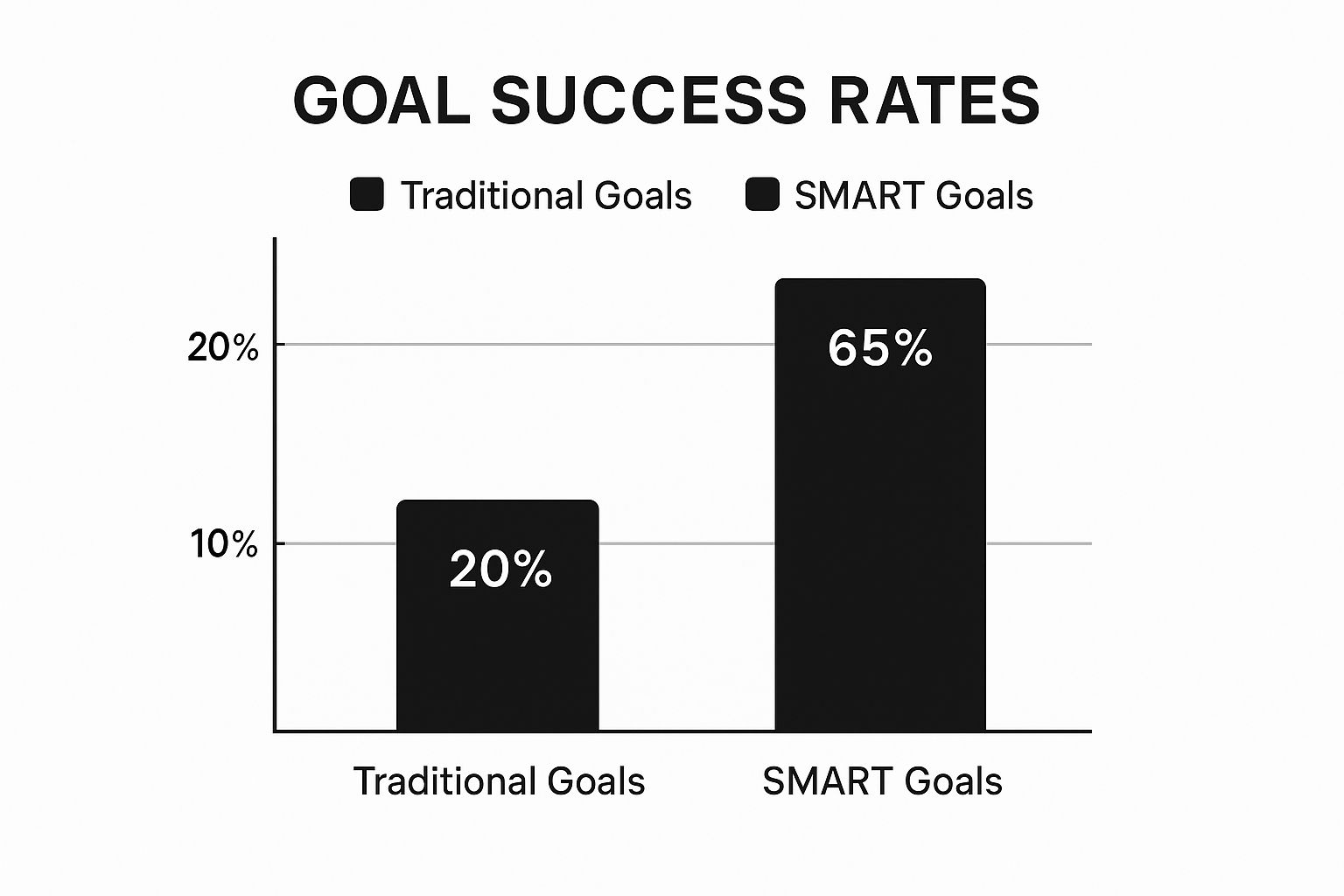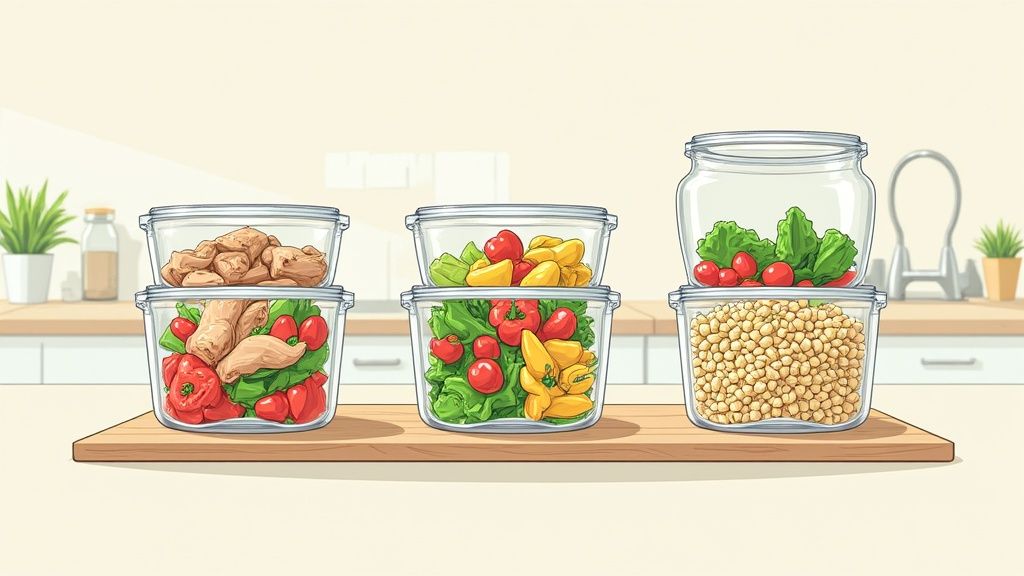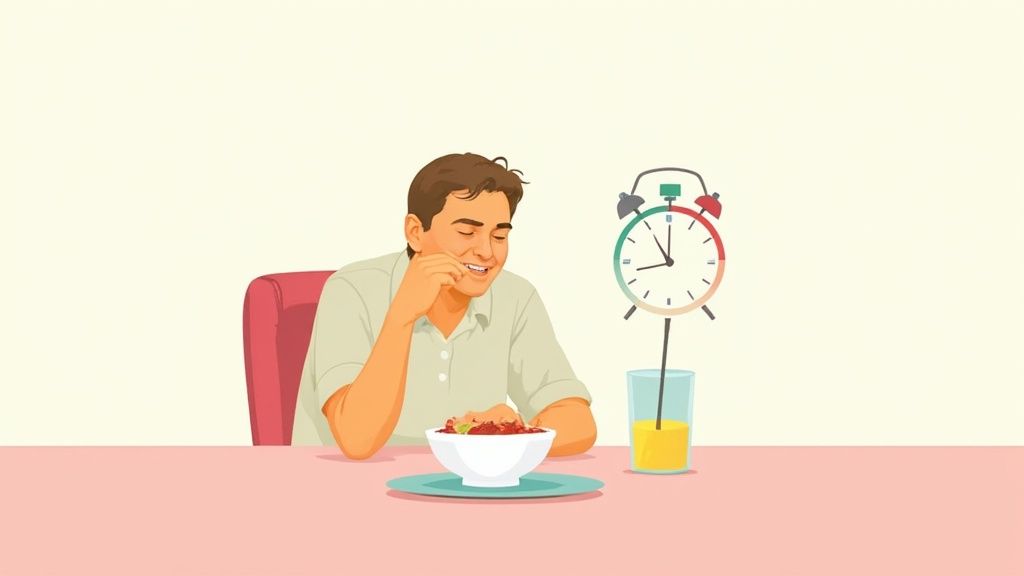How to Break Bad Eating Habits: Proven Tips for Success

If you've ever tried to break a bad eating habit, you know it feels way more complicated than it should. The secret isn't just about white-knuckling it through cravings. It's about a smarter approach: first, pinpoint your specific triggers, then get to know the habit loop that keeps you stuck, and finally, swap out that old routine with a new, healthier one that still gives you a satisfying reward.
This method works so much better than just relying on sheer willpower.
Why Is It So Hard to Change How We Eat?
Let's get one thing straight: if you're struggling to change your eating habits, it’s not because you're weak or lack desire. The real culprit is the powerful, automatic patterns your brain has built up over years. You're not just fighting a craving; you're up against deeply ingrained behaviors that run on autopilot.

Most of these patterns boil down to a simple, three-part cycle called the habit loop:
- The Cue: This is the trigger that sets everything in motion. It could be a specific time (that 3 p.m. energy dip), a feeling (work stress), a place (driving past your favorite fast-food joint), or even a person.
- The Routine: This is the action you take—the habit itself. Maybe it's grabbing a sugary soda, ordering takeout after a long day, or mindlessly eating chips in front of the TV.
- The Reward: This is the payoff you get from the routine, the very thing that makes your brain want to do it again. It might be a quick hit of pleasure, a distraction from boredom, or a moment of comfort.
The Brain Science Behind Our Food Choices
Our brains are hardwired for efficiency and pleasure. When you eat something loaded with sugar or fat, your brain gets a hit of dopamine—the "feel-good" chemical. This creates a powerful connection that tells your brain, "Hey, when that happens, do this to feel good."
This is a huge part of emotional eating, where food becomes a tool to cope with tough feelings. To really make a change, you have to untangle these emotional wires. If this sounds familiar, you can learn more about how to stop emotional eating in our detailed guide.
Your brain doesn't label habits as "good" or "bad." It just knows what's familiar and what feels rewarding. The trick is to make a new, healthier habit just as easy—and appealing—as the old one.
Roadblocks Outside of Our Control
It's not all in our heads, either. The world around us throws up some serious barriers to healthy eating. For a lot of people, the biggest hurdle is cost.
As of 2025, it's estimated that a staggering 2.8 billion people worldwide simply can't afford a healthy diet. This economic reality often pushes families toward cheaper, calorie-dense foods that are low in nutrients, making it incredibly difficult to break unhealthy cycles.
Recognizing that you're working against both powerful internal programming and real-world external pressures is the first, most important step toward making a lasting change.
Pinpoint Your Personal Eating Triggers
If you want to get a handle on your eating habits, you have to play detective for a little while. It’s rarely about the food itself. It’s almost always about why you’re reaching for it in the first place. Those moments when you find yourself in front of the fridge, not even hungry, are driven by hidden triggers. The first real step toward change is figuring out what they are.
For just one week, grab a notebook or use a tool like the mood tracker in the StopSugar app and keep a simple journal. This isn't about counting calories or feeling guilty. It’s about gathering clues. Every time you eat something—especially when it's an unplanned snack—take a second to jot down a few details.
What to Look For
Your mission is to connect the dots between your surroundings, your feelings, and your food choices. This is where real insight comes from, and it's the foundation for making changes that actually stick.
Pay attention to these key details:
- What did you eat? Be specific. "Three chocolate chip cookies" tells you more than "a snack."
- When was it? Note the time. You might start seeing that 3 PM slump is a danger zone.
- Where were you? At your desk? In the car? On the couch watching TV? The environment is a powerful cue.
- How were you feeling? This is the goldmine. Were you bored? Stressed? Lonely? Or were you actually, truly hungry?
After a few days, you'll start to see patterns. You might realize that a stressful work email always sends you searching for sugar, or that Sunday afternoon boredom is a direct pipeline to the pantry.
Understanding the 'why' behind the habit is so much more powerful than just fighting the urge. Once you know the trigger, you can take apart the whole routine.
Common Eating Triggers and How to Spot Them
Once you have about a week's worth of notes, you can start making sense of it all. Most triggers fall into a few common categories. Use this table to recognize your own patterns. Tracking these situations for a week can reveal the 'why' behind your eating habits.
| Trigger Category | What It Feels Like | Common Scenario Example |
|---|---|---|
| Emotional | Eating because of feelings—stress, boredom, sadness, even celebration. | Finishing a tough day at work and immediately reaching for ice cream. |
| Environmental | Cues in your surroundings that make you want to eat, often without thinking. | Walking past the candy bowl on the receptionist's desk and grabbing a piece every time. |
| Social | Feeling pressured to eat because of the people you're with. | Ordering a heavy dessert you don't really want because everyone else at the table is. |
| Situational | Habits that are tied to a specific activity or time of day. | Automatically making a bag of popcorn for a movie, even if you just ate dinner. |
Pinpointing which category your triggers fall into helps you move from a vague goal like "I need to eat better" to a concrete, targeted plan of attack. And that's where the magic happens.
This chart shows just how much of a difference a specific plan makes compared to a general wish.

As you can see, having a smart, defined plan drastically improves your chances of success. Now that you've identified your triggers, you're ready to build that plan.
Create New Habits That Actually Stick

Knowing your triggers is a huge step, but it's only half the battle. The other, more crucial half is deciding what you’ll do instead. You can't just stop a bad habit cold turkey; you have to replace it with something better that satisfies the same deep-seated need. This is the secret to breaking bad eating habits for good.
Let's say you've figured out that stress sends you straight to the vending machine for a candy bar. The reward you're really chasing isn't the chocolate itself. It's the moment of relief, the distraction from whatever is stressing you out. So, the trick is to find a new, healthier routine that gives you that same feeling of escape.
Build Your Toolbox of Alternatives
I like to think of this as creating a personal "menu" of positive actions you can choose from the moment a trigger hits. The key is to make your new, healthy habit just as easy—if not easier—than the old one. If your go-to stress reliever is in the kitchen pantry, your new one needs to be just as close at hand.
Here are a few practical ideas for replacing common triggers:
- Triggered by stress? Instead of reaching for sugar, try a five-minute guided meditation on your phone. Or maybe just step outside for some fresh air or blast one of your favorite feel-good songs. The reward? A clear head and a sense of calm.
- Triggered by boredom? Rather than mindlessly snacking, send a quick text to a friend you haven't talked to in a while. Do a quick ten-minute tidy-up of your desk or living room. Even just a few good stretches can work wonders. The reward is engagement and a small sense of accomplishment.
- Triggered by fatigue? Before you grab a sugary drink for that temporary jolt, try drinking a large glass of ice-cold water first. A few jumping jacks can also do the trick. The reward is real energy, not a crash waiting to happen.
The replacement has to be simple and give you an immediate positive feeling. If you want to dive deeper into this, we have some great info on the science of building healthy habits over on our blog.
Your new habit doesn't have to be some monumental life change. In fact, it's better if it isn't. The easier the replacement is, the more likely you'll stick with it until it feels completely automatic.
Rehearse Your New Routine
Once you have a few go-to alternatives for your biggest triggers, it's time to practice. I mean actually practice, in your head. Close your eyes and visualize the scenario. You feel that 3 PM wave of boredom washing over you at your desk. Instead of picturing yourself walking to the pantry, you see yourself standing up, putting on your headphones, and taking a quick walk around the office.
This mental rehearsal makes a massive difference. It's a psychological technique that primes your brain for the new behavior, so when the real moment arrives, your new choice feels more natural and less like an internal struggle.
Here's how you can map it out for yourself:
| When I feel this... | Instead of this... | I will do this... |
|---|---|---|
| Overwhelmed by work emails | Eating cookies at my desk | Walk to the kitchen and make a cup of herbal tea |
| Tired on the couch after dinner | Grabbing a bowl of ice cream | Do a 5-minute stretching routine |
| Anxious about a deadline | Ordering greasy takeout | Use the "Panic Button" feature in the StopSugar app |
This simple structure turns a vague goal like "I want to eat better" into a concrete, actionable plan. By consciously designing and practicing these new responses, you're actively rewiring the automatic habits that held you back, making healthier choices feel like second nature over time.
Embrace Small Changes for Big Results

The thought of a complete diet overhaul is enough to make anyone want to give up before they even start. It’s just too much, too soon. This “all-or-nothing” approach almost always backfires, leaving you feeling deprived and making those old, comforting habits look better than ever. It's a classic trap.
But what if you didn’t have to change everything at once? Real, lasting success comes from making small, almost unnoticeable adjustments that add up over time. Instead of fixating on what you need to cut out, just focus on one tiny thing you can add or swap.
This strategy is powerful because it sneaks past your brain's resistance to change. It’s not intimidating. It gives you small, quick wins that build the kind of momentum that's hard to stop.
The Power of One Small Swap
Take a look at your daily routine. Where’s one spot you could make a single, easy change? We’re not aiming for perfection here, just a little bit of progress.
Let’s get practical. Here’s what this looks like in real life:
- Instead of: Swearing off soda for good on day one.
- Try this: Just replace one of your daily sodas with a glass of sparkling water and a squeeze of lime. That's it.
- Instead of: Committing to cooking seven healthy dinners a week (a huge task!).
- Try this: Just focus on prepping one healthy lunch for the week ahead, like a big container of quinoa salad.
These tiny tweaks might not feel like a big deal, but they are the bedrock of genuine habit change. Research backs this up, showing that trying to transform your diet overnight is a recipe for failure. In fact, studies suggest that changing just one or two small eating habits at a time leads to a 50-60% higher success rate for keeping those changes over six months. You can find more insights on nutrition trends at the Global Wellness Institute.
The secret to breaking a bad eating habit is making the new, healthy choice so ridiculously easy that your brain doesn’t even bother to fight it. Consistency with a small change will always beat intensity with an unsustainable one.
Build Your Momentum, Brick by Brick
After a week or two, once that first small change starts to feel like second nature, you’re ready for the next step. It's time to add another small habit. This is how you build a strong foundation, brick by brick, without ever feeling overwhelmed.
Think about it like learning to play the guitar. You don't try to shred a complex solo on your first day. You start with a few simple chords. You get comfortable with one, then you add another.
Here’s how this could unfold over a few weeks:
- Week 1: Swap your 3 PM candy bar for a handful of almonds.
- Week 2: Keep the almond swap going and start your day with a glass of water before you have anything else.
- Week 3: Stick with the first two habits and add one serving of vegetables to your dinner.
See how that works? Each step is small and totally manageable on its own. By focusing on one little victory at a time, you build the confidence you need and prove to yourself that you can do this. This slow-and-steady approach removes the pressure that causes so many people to quit before they even get a chance to succeed.
Make Healthy Choices Easy by Redesigning Your Space
Let's be honest: trying to resist temptation with willpower alone is exhausting. It's a battle you’ll lose eventually, especially on a tough day. A much better approach is to stop fighting so hard in the first place. You can actually set up your environment so that making healthy choices is the easiest, most natural thing to do. When your surroundings support your goals, good habits start to feel automatic.
The idea is simple. We want to remove the roadblocks to good habits and create roadblocks for the bad ones. Think of it as rigging the game in your favor. It all starts by taking a look at your kitchen, your desk at work, and even your social life. With a few small, deliberate changes, you can seriously cut down on the daily temptations that throw you off track.
Set Up Your Kitchen and Workspace for Success
Your kitchen should be your sanctuary, not a minefield of sugary snacks and processed foods. The old saying "out of sight, out of mind" is your best friend here. If the junk food isn't in the house, you can't eat it.
- Make Healthy Food Obvious: Keep healthy options front and center. When you open your fridge, you should immediately see fresh-cut vegetables, containers of Greek yogurt, and maybe a pitcher of fruit-infused water.
- Hide the Temptations: If you have to keep less-healthy foods around for others, stick them on a high shelf or in the back of the pantry. Better yet, just don't bring them home from the store.
- Hydrate at Your Desk: Always keep a reusable water bottle on your desk. So often, we think we're hungry when we're actually just thirsty. Staying hydrated is a simple way to prevent mindless snacking.
If you’re a busy professional, your office environment is just as crucial. For more ideas tailored to that, check out our healthy eating tips for busy professionals.
By consciously choosing what's visible and easy to grab, you're stacking the deck in your favor. It's not about resisting a cookie anymore; it's about making it so inconvenient to get one that you have time to remember your goals.
This isn't just a personal trick; it's backed by large-scale evidence. A World Health Organization survey revealed that about 70% of people trying to improve their diet point to a lack of supportive environments or access to good food as a major hurdle. We've seen this play out in public policy, too. When Chile introduced mandatory warning labels on foods high in sugar, the country saw a 23% drop in sugary drink purchases within just two years.
Navigate Social Events Like a Pro
Your environment isn't just your home or office—it includes social situations, which can be full of food traps. But with a little planning, you can navigate parties and dinners out without derailing your progress.
Going to a restaurant? Check out the menu online before you go. Make a healthy choice in advance, so you aren't tempted by what everyone else is ordering in the moment. If you're heading to a potluck or party, offer to bring a healthy dish that you genuinely enjoy. That way, you know there will be at least one great option for you, and you might even help someone else make a better choice, too.
Got Questions About Changing Your Habits? We’ve Got Answers.
When you start the process of ditching bad eating habits, it’s completely normal for a bunch of questions to pop up. You’re probably wondering how long this is all going to take, what to do when you inevitably slip up, or how to handle a pizza party at work. Getting some straight answers on these common sticking points can make you feel much more prepared for the journey.
How Long Does It Really Take to Break a Bad Eating Habit?
You’ve probably heard the old 21-day myth. The truth is, it’s not that simple. Research has shown that creating a new habit can take anywhere from 18 to a whopping 254 days. That’s a huge range, and it all depends on you, the habit you're trying to build, and what's going on in your life at the time.
So, instead of getting hung up on a magic number, just focus on being consistent. It’s not about being perfect; it’s about making the healthier choice more often than not. Think of it as slowly rewiring your brain. Every time you opt for the new, better routine, you're making that mental pathway a little stronger. Patience is your best friend here.
What Should I Do If I Have a Slip-Up?
First things first: breathe. A slip-up isn't a failure—it's just a piece of information. The biggest mistake I see people make is falling into the all-or-nothing trap. One cookie derails their entire day, and they figure, "Well, I've already blown it, might as well finish the box."
Don't let that be you. Acknowledge what happened, but leave the guilt behind. Instead, get curious. What was the trigger? Were you feeling stressed out? Tired? In a specific social setting? Use that insight to make a better plan for next time. Then, get right back on track with your very next meal. It’s the overall pattern that matters, not one single misstep.
A single mistake doesn't undo all the progress you've made. It's just a chance to learn, reset, and keep going. Resilience isn't about never stumbling; it's about how quickly you get back up.
How Can I Handle Social Events Without Sabotaging Myself?
Ah, the social gathering. It's probably one of the toughest hurdles when you're trying to eat better. The secret to getting through them without feeling deprived or giving in completely is to walk in with a solid plan.
- Have a healthy snack before you go. Showing up starving is a recipe for disaster. A handful of almonds or an apple can curb that initial hunger spike.
- Do a quick scan. Before you grab a plate, survey the buffet or menu for healthier choices. Spot the grilled chicken, salad, or roasted veggies and decide what you'll have first.
- Make people the main event, not the food. Shift your focus to conversations. Grab a seltzer with lime to keep your hands occupied and cut down on mindless nibbling.
My Family Isn't on Board. How Do I Stay on Track?
This is a tough one, and it's incredibly common. When your own home doesn't feel supportive of your goals, you'll need a little extra determination. But it’s definitely doable. You can't control what others eat, so pour all your energy into what you can control—your own plate.
Try leading by example, not by lecturing. Cook your own healthy meals or offer to bring a healthy side dish to family dinners that everyone can try. If someone gives you a hard time, just calmly explain that you’re doing this for your health. Your quiet consistency will say more than any lecture ever could, and who knows, you might even inspire them down the road. Just remember, you're doing this for you.